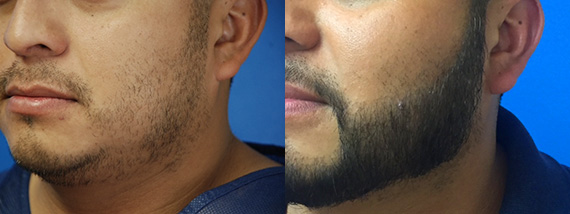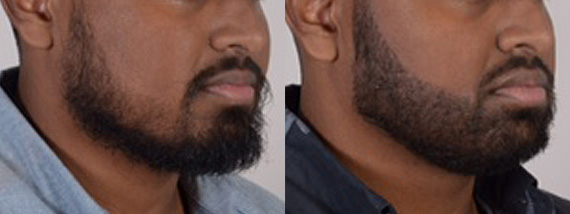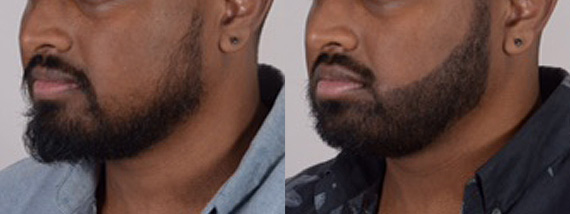Beard Restoration
For many men being able to have a full beard or goatee is almost like a badge of honor. It can signify manhood, provide the feeling of being an alpha male, or simply it can help improve or hide certain facial features.
Beard Hair Transplant: Enhancing Facial Features

A beard hair transplant, also referred to as a facial hair transplant, is a cosmetic procedure aimed at achieving a fuller, thicker beard by transplanting hair from one part of the body, typically the scalp, to the beard area.
Resurgence of Beard Popularity
Beards have cycled in and out of fashion throughout history, experiencing periods of both high and low popularity. In recent times, there has been a notable resurgence in the interest and admiration for beards. Several factors contribute to this resurgence:
Symbolism of Masculinity and Virility
Beards are often perceived as symbols of masculinity and virility, leading many men to grow them as a means of expressing their manliness. This symbolic association with masculinity contributes to the appeal of beards in contemporary culture.
Embracing Natural and Rugged Looks
There is a growing trend towards embracing natural and rugged aesthetics, and beards align well with this trend. Many individuals opt for beards as they offer a rugged, yet stylish appearance that resonates with the desire for authenticity and natural beauty.
Expression of Individuality
In a world where conformity to mainstream styles and trends is common, beards provide a means of standing out and expressing individuality. With numerous people adopting similar looks, a beard becomes a distinctive feature, allowing individuals to make a unique statement and assert their personal style.
The lack of ability to grow a perfect beard has a variety of different factors to consider like:
- Hormonal imbalances
- Genetics
- Skin infections
- Facial burns or scarring
- Stress or anxiety
- Alopecia barbae
- Vitamin A deficiency
- Deficiency of amino acids for necessary growth
This causes men to start testing different methods to try and grow a natural looking beard using serums or supplements, though these sometimes don’t provide the desired effect and leads them to think if there are any other solutions.
Well, the good news is that there are. Just like how hair can be restored on top of the head, there are similar techniques that can help restore the hair on your fac




The primary procedure used for beard restoration is Follicular Unit Excision (FUE), wherein Dr. Katona locates a suitable donor area—typically either the face or head—to extract hair follicles. These follicles are then transferred to the desired jaw or chin area to enhance fullness.
The newly transplanted facial hair blends seamlessly with existing hair for a natural appearance, with close attention paid to maintaining consistency in the donated hair follicles post-transfer.
Performed under local anesthesia, the entire procedure ensures minimal discomfort for the patient and can last from four to eight hours, depending on the required hair volume.
In the following weeks, it’s common for transplanted hairs to shed, marking a natural phase of the process. Most men notice new hair growth within three months, achieving the desired full, natural beard.
Here’s a summary of the procedure:
- Consultation: Meet with Dr. Katona to assess your beard area, discuss goals, and determine candidacy.
- Harvesting Hair Follicles: Numbing the donor area, individual hair follicles are carefully extracted, ensuring survival, and closure of the donor site.
- Preparing Grafts: Extracted follicles are prepared for transplantation, separated into individual grafts, each containing one to three hairs.
- Transplantation: Dr. Katona creates small incisions in the beard area and inserts the grafts, positioning them at precise angles and densities for a natural appearance.
- Aftercare: Post-procedure care instructions include avoiding strenuous activities, maintaining cleanliness, and taking medication as prescribed for optimal healing and infection prevention.
It’s essential to recognize that beard hair transplant is a surgical procedure demanding expertise and experience for safe and successful execution. Dr. Katona specializes in facial hair transplantation, including eyebrows, beards, and facial scars, ensuring exceptional outcomes.
Am I a Candidate for Beard Restoration?
Candidates for a beard hair transplant typically have bald or patchy beards they wish to fill in, or seek to conceal facial scars or other imperfections.
During a complimentary consultation with Dr. Katona, he can determine whether you’re a suitable candidate for a beard restoration. If there’s an appropriate donor area, chances are high that you’ll qualify for the procedure.
Dr. Katona and his team excel in delivering optimal results for patients at an affordable cost, thanks to their advancements in the field.
While the specifics of the procedure vary for each individual, it’s crucial to undergo a consultation to evaluate the donor area, assess the beard, and receive comprehensive information about the procedure.
Book your complimentary consultation here! We also offer over-the-phone consultations for your convenience.
